ADVERTISEMENT
Salt and Baking Soda Method: Combine 1/4 cup of salt with 1/2 cup of baking soda and follow the same steps. Salt helps to break down grease, and the combination creates a more robust reaction.
Plunger Technique: After using the baking soda and vinegar method, try using a plunger for added pressure to clear any remaining debris. Ensure the drain is covered with enough water to create a proper seal.
Lemon Juice for a Fresh Scent: If you prefer a fresh scent in your kitchen or bathroom, substitute lemon juice for vinegar. The acidity will work similarly, while leaving your space smelling fresh.
FAQs:
How often should I unclog my drains? For best results, perform a preventive cleaning once a month using this method. However, if you notice slow drainage or a strong odor, it’s time to unclog your drain immediately.
Will this work for all types of clogs? This method works well for light to moderate clogs, especially those caused by soap scum, hair, or grease buildup. Severe blockages may require a plumber's attention or the use of more industrial-strength solutions.
Can I use this method in the kitchen sink? Yes, this remedy works well in the kitchen sink, especially for grease and food residue. However, if you regularly deal with food particles, consider using a drain strainer to prevent future clogs.
Can I use this method in a shower or bathtub drain? Absolutely! This method is effective for bathroom drains as well. If you have a lot of hair buildup in the drain, you may want to use a hair catcher to prevent future issues.
By using these simple, eco-friendly methods, you can quickly and easily unclog your drain without resorting to harsh chemicals. Keep your pipes clean, clear, and flowing freely with these natural remedies!
ADVERTISEMENT
